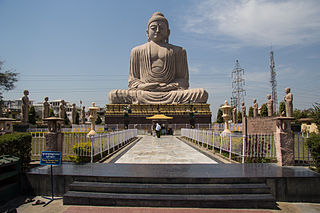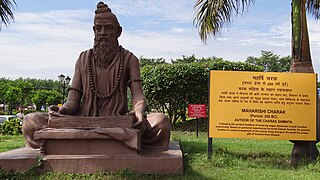Related Research Articles
Nyāya, literally meaning "justice", "rules", "method" or "judgment", is one of the six astika schools of Indian philosophy. This school's most significant contributions to Indian philosophy were systematic development of the theory of logic, methodology, and its treatises on epistemology. Ancient Mithila University was famous for Nyaya Shastra teaching.

Kaṇāda, also known as Ulūka, Kashyapa, Kaṇabhaksha, Kaṇabhuj was an ancient Indian natural scientist and philosopher who founded the Vaisheshika school of Indian philosophy that also represents the earliest Indian physics.
Dialetheism is the view that there are statements that are both true and false. More precisely, it is the belief that there can be a true statement whose negation is also true. Such statements are called "true contradictions", dialetheia, or nondualisms.

The Nyāya Sūtras is an ancient Indian Sanskrit text composed by Akṣapāda Gautama, and the foundational text of the Nyaya school of Hindu philosophy. The date when the text was composed, and the biography of its author is unknown, but variously estimated between 6th-century BCE and 2nd-century CE. The text may have been composed by more than one author, over a period of time. The text consists of five books, with two chapters in each book, with a cumulative total of 528 aphoristic sutras, about rules of reason, logic, epistemology and metaphysics.
The development of Indian logic dates back to the anviksiki of Medhatithi Gautama ; the Sanskrit grammar rules of Pāṇini ; the Vaisheshika school's analysis of atomism ; the analysis of inference by Gotama, founder of the Nyaya school of Hindu philosophy; and the tetralemma of Nagarjuna.

Buddhism and Jainism are two Indian religions that developed in Magadha (Bihar) and continue to thrive in the modern age. Gautama Buddha and Mahavira are generally accepted as contemporaries. Jainism and Buddhism share many features, terminology and ethical principles, but emphasize them differently. Both are śramaṇa ascetic traditions that believe it is possible to attain liberation from the cycle of rebirths and deaths (samsara) through spiritual and ethical disciplines. They differ in some core doctrines such as those on asceticism, Middle Way versus Anekantavada, and self versus not-self.
Bimal Krishna Matilal was an eminent British-Indian philosopher whose writings presented the Indian philosophical tradition as a comprehensive system of logic incorporating most issues addressed by themes in Western philosophy. From 1977 to 1991, he was the Spalding Professor of Eastern Religion and Ethics at the University of Oxford.
Yāska was an ancient Indian grammarian and linguist [est. 7th–5th century BCE(disputed)]. Preceding Pāṇini [est. 7th–4th century BCE(disputed)], he is traditionally identified as the author of Nirukta, the discipline of "etymology" within Sanskrit grammatical tradition and the Nighantu, the oldest proto-thesaurus in India. Yaska is widely regarded as the precursive founder of the discipline of what would become etymology in both the East and the West. "यास्काचार्यो यस्कस्य अपत्यं स्यात्" The name Yaaska is probably a patronymic name meaning of Yaska यस्क. It is uncertain however who Yaska यस्क could have been."अपि पाणिनीयदृश्यते" The patronymic of Yaska is also seen in Panini's great work: The Astadhyayi. The list of Brihadaranyaka Upanishad, regarding, vamshas, says that Yaska could be a teacher of Bharadwaj भरद्वाज or a contemporary of him.
Anekāntavāda is the Jain doctrine about metaphysical truths that emerged in ancient India. It states that the ultimate truth and reality is complex and has multiple aspects.

The Charaka Samhita is a Sanskrit text on Ayurveda. Along with the Sushruta Samhita, it is one of the two foundational texts of this field that have survived from ancient India. It is one of the three works that constitute the Brhat Trayi.
Vaiśeṣika Sūtra, also called Kanada sutra, is an ancient Sanskrit text at the foundation of the Vaisheshika school of Hindu philosophy. The sutra was authored by the Hindu sage Kanada, also known as Kashyapa. According to some scholars, he flourished before the advent of Buddhism because the Vaiśeṣika Sūtra makes no mention of Buddhism or Buddhist doctrines; however, the details of Kanada's life are uncertain, and the Vaiśeṣika Sūtra was likely compiled sometime between 6th and 2nd century BCE, and finalized in the currently existing version before the start of the common era.
Udayana, also known as Udayanācārya, was an Indian philosopher and logician of the tenth century of the Nyaya school who attempted to devise a rational theology to prove the existence of God using logic and counter the attack on the existence of God at the hands of Buddhist philosophers such as Dharmakīrti, Jñānaśrī and against the Indian school of materialism (Chārvaka). He is considered to be the most important philosopher of the Nyāya tradition.

Buddhist logico-epistemology is a term used in Western scholarship for pramāṇa-vāda and Hetu-vidya. Pramāṇa-vāda is an epistemological study of the nature of knowledge; Hetu-vidya is a system of logic. These models developed in India during the 5th through 7th centuries.
The Madhyamakālaṃkāra is an 8th-century Buddhist text, believed to have been originally composed in Sanskrit by Śāntarakṣita (725–788), which is extant in Tibetan. The Tibetan text was translated from the Sanskrit by Surendrabodhi and Jñānasūtra.
Trairūpya is a conceptual tool of Buddhist logic. The Trairūpya, ‘three conditions’, is oft accredited to Dignaga though is now understood to have originated with his teacher Vasubandhu in the Vāda-vidhi, post-reconstruction of this work by Frauwallner (1957).
Hetucakra or Wheel of Reasons is a Sanskrit text on logic written by Dignaga. It concerns the application of his 'three modes’ (trairūpya), conditions or aspects of the middle term called hetu or linga in a valid inference within the Indian logico-epistemic tradition, sometimes referred to as Buddhist logic.
Arindam Chakrabarti is, currently, a visiting professor of philosophy at Ashoka University, India. He is, also, a professor of philosophy at Stony Brook University, where he has been since 2018. Prior to moving to Stony Brook, Chakrabarti taught at the University of Hawaii, where he was the director of the EPOCH Project.
Padārtha is a Sanskrit word for "categories" in Vaisheshika and Nyaya schools of Indian philosophy.

Jonardon Ganeri, FBA, is a philosopher, specialising in philosophy of mind and in South Asian and Buddhist philosophical traditions. He holds the Bimal Matilal Distinguished Professorship in Philosophy at the University of Toronto. He was Global Network Professor in the College of Arts and Science, New York University, previously having taught at several universities in Britain. Ganeri graduated from Churchill College, Cambridge, with his undergraduate degree in mathematics, before completing a DPhil in philosophy at University and Wolfson Colleges, Oxford. He has published eight monographs, and is the editor of the Oxford Handbook of Indian Philosophy. He is on the editorial board of the Stanford Encyclopedia of Philosophy, the British Journal for the History of Philosophy, Philosophy East & West, Analysis, and other journals and monograph series. His research interests are in consciousness, self, attention, the epistemology of inquiry, the idea of philosophy as a practice and its relationship with literature. He works on the history of ideas in early modern South Asia, intellectual affinities between India and Greece, and Buddhist philosophy of mind, teaches courses in the philosophy of mind, the nature of subjectivity, Buddhist philosophy, the history of Indian philosophical traditions, and supervises graduate students on South Asian philosophical texts in a cross-cultural context. He is a prominent advocate for an expanded role for cross-cultural methodologies in philosophical research, and for enhanced cultural diversity in the philosophical curriculum. Jonardon Ganeri is the inventor of the idea of "cosmopolitan philosophy" as a new discipline within philosophy.
Heeraman Tiwari is a Professor of Centre for Historical Studies, School of Social Sciences, at the Jawaharlal Nehru University, New Delhi and his core areas of study include Sanskrit Language, Literature, Intellectual History and Philosophy.
References
- ↑ Bimal Krishna Matilal; Jonardon Ganeri; Heeraman Tiwari (1998). The Character of Logic in India (PDF). SUNY Press. p. 2. ISBN 9780791437407 . Retrieved 27 November 2016.
- ↑ Bimal Krishna Matilal; Jonardon Ganeri; Heeraman Tiwari (1998). The Character of Logic in India. SUNY Press. p. 31. ISBN 9780791437407.
- ↑ Bimal Krishna Matilal; Jonardon Ganeri; Heeraman Tiwari (1998). The Character of Logic in India. SUNY Press. p. 32. ISBN 9780791437407.
- 1 2 3 Satis Chandra Vidyabhusana (1920). A History of Indian Logic: Ancient, Mediaeval and Modern Schools. Delhi: Motilal Banarsidas. pp. 25–35. ISBN 9788120805651.
- ↑ Karin Preisendanz (2009). "Logic, Debate, and Epistemology in Ancient Indian Medical Science" (PDF). Indian Journal of History of Science. 44 (2): 261–312. Retrieved 27 November 2016.
- ↑ Bimal Krishna Matilal; Jonardon Ganeri; Heeraman Tiwari (1998). The Character of Logic in India. SUNY Press. pp. 31–59. ISBN 9780791437407.
- ↑ Perdue, David. "Tibetan Buddhist Debate". Asia Society. Retrieved 2021-02-07.
The Tibetan argument forms were brought over with minor adaptations from the Indian logical forms.
- 1 2 Perdue, David. "Tibetan Buddhist Debate". Asia Society. Retrieved 2021-02-07.
- ↑ Wangkhang, Rignam (2019-09-19). "Debating the Buddhist Masters". Tricycle.org. Trycicle. Retrieved 2021-02-07.
Arms raised, voices raised, hands clapping, rosaries clasped, crowds watching.
